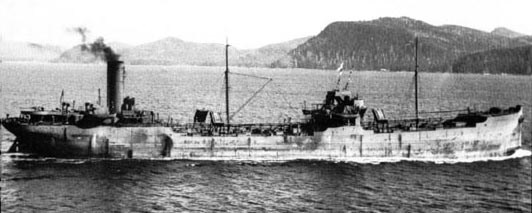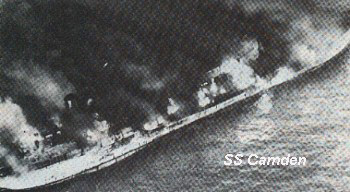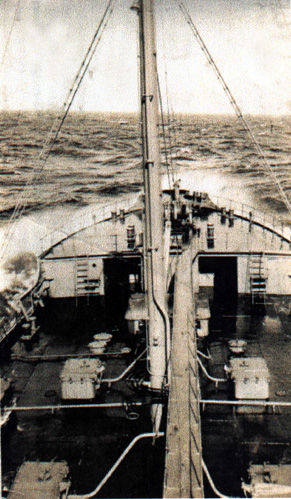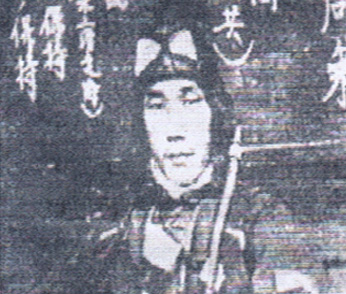SS Albertolite

|
|
Photo Source:
Robert G. Halford's The Unknown Navy: Canada's
WWII Merchant Navy.
|
The SS Albertolite
was an oceangoing steam-powered
9,600-DWT tanker built in 1912 as the
Adorna
(Click for details).
She survived the First
World War and was renamed
Caddo
after the war. In 1929 she was purchased by
Imperial Oil Limited,
the Canadian subsidiary of Standard Oil
of New Jersey. Imperial Oil christened her
Albertolite,
and she was the second of the company's ships to bear that name.
Albertolite serviced Imperial Oil's Pacific
routes, bringing
crude oil from various ports in South America
and California to the company's
terminus at
Ioco, British Columbia.
By time the Second World War
broke out in September 1939,
Albertolite was the
oldest vessel
in the company's fleet of ten oceangoing tankers,
and she was ready for retirement, but the war
and the slaughter of Allied merchant shipping,
put an end to those plans.
During World War Two the Imperial Oil fleet,
which included lake and coastal tankers as well as the
ocean-going ships, played a vital part in the war effort.
The price in men and ships
was costly and by time the war ended Imperial
Oil's oceangoing fleet had been
nearly halved by enemy action:
MV Candolite
and her whole crew
were captured by the German raider
Kormoran on 25 March 1941 --
the men spent the rest of the war in the German
POW
(Prisoner of War)
camp at
Marag und Milag Nord;
MV Montrolite

Canadian Merchant Navy Badge
|
was torpedoed by
U-109
en route to Halifax from Venezuela
on 4 February 1942 with the loss of 28 lives;
MV Victolite
was torpedoed by
U-564 on 10 February 1942
with the loss of her entire crew of 47;
and
MV Calgarolite
was torpedoed by
U-125 on 4 February 1942
-- all her crew members managed to reach shore safely
in the ship's lifeboats.
Before the USA entered the war
Imperial Oil also managed seventeen
American-owned, but
Panamanian-flagged tankers. One of them, the
MV Joseph Seep ,
was mined in Le Havre, France
on May 25th, 1940, and another, the
MV James McGee
was mined in the Bristol Channel on June 20th,
1940. Although no one was killed on either ship, three
men aboard James McGee were injured. As
the war progressed Imperial Oil also took over the management
of thirteen of the Canadian-built "Park" tankers.
One of them, the
SS Nipiwan Park ,
was torpedoed off Halifax
on January 4th, 1945 with the
loss of two lives.

|
|
Ian Ferguson, WWII
|
|
The following pictures on this page are from the collection
of former British Merchant Sailor
Ian Ferguson. Ian's
first ship was
the British cargo vessel
SS Shaftesbury which he
joined at Leith, Scotland, in May 1941,
when he was just 16 years of age.
On 12 July 1942
SS Shaftesbury was
attacked in the Atlantic Ocean, off the Azores,
by the German "pig boat"
U-116, one of the eight large
Type XB Minelayer
U-boats in service during the war.
Fortunately for Ian,
by the summer of 1942
he had already
left
the Shaftesbury
and signed aboard the Albertolite
at
her home port of
Vancouver, British Columbia.
Under the command of her
master
Captain Mosher, Albertolite
was continuing her usual service
but, by December 1941,
the waters which the tanker frequented had become very
dangerous.
After the Japanese
bombed Pearl Harbor
on December 7th, 1941,
nine of their submarines which had which had patrolled a line
120 miles north of Oahu during the attack,
quickly moved east to target
merchant ships off the coasts of California and Oregon.
On December 20th, 25 miles from
Cape Mendocino,
California, I-17 (Nishino)
torpedoed and
sank the American tanker
SS Emidio,
with the loss of five lives.
The next day I-23 (Shibata)
attacked the American tanker
SS Agwiworld
south of Monterey Bay, but she got away.
On December 22nd,
the American tanker
SS H.M. Storey,
had a lucky escape when she was attacked by
I-19 (Narahara) only 2 miles off
Point Arguello, California --
she was saved by the timely arrival of a Navy plane which
dropped depth charges and
forced the submarine to dive. Unfortunately,
the tanker would not be
so lucky in the future.
On December 23rd I-17 struck again
off northern California, but her
intended victim,
the American tanker
SS Larry Doheny,
got away -- like
H.M. Storey, she would not be so lucky the next time.
Also on December 23rd, the submarine I-21 (Matsumura)
torpedoed the tanker
SS Montebello,
off the coast of northern California,
and then proceeded to
machine-gun the survivors
in the water. Miraculously, all of
Montebello's 38 crew members
survived the murderous atrocity.
A short time later that same day I-21
attacked the American tanker
SS Idaho,
but, luckily for all aboard,
Idaho escaped her vicious attacker.
The following day, December 24th, I-19 (Narahara),
succeeded in torpedoing the American freighter
SS Absaroka,
about 26 miles off
San Pedro, California.
Although Absaroka survived the attack, one of
her crew members was killed.
On Christmas Day, Agwiworld's earlier
attacker, I-23,
was again unsuccessful when she shelled
the American freighter
SS Dorothy Philips
in
Monterey Bay.
The last Japanese attack in the area
took place on the 28th of December when
I-25,
under the command of
Lieutenant Commander Meiji Tagami,
attempted to torpedo
the American tanker
SS Connecticut,
only 10 nautical miles off
the mouth of the
Columbia River, Oregon.
Fortunately, Connecticut, although damaged, managed to
escape -- she ended up running aground at the
mouth of the Columbia River -- but her reprieve was only temporary.
On
April 23rd, 1942 in the South Atlantic,
Connecticut was sunk
in a horrific attack
by torpedo boat LS-4 from the German raider
Michel.
35 men died at the scene; 1 more died aboard the raider;
and of the 18 survivors, 2 more
died under the barbaric conditions inflicted upon them
as POW's of the Japanese.
After their December 1941 attacks
off the coast of California and Oregon,
the Japanese submarines withdrew from the northwest coast
waters, but it would not be long
before they would
return.
Japanese Submarine I-26

On the same day as
Pearl Harbor,
December 7th, 1941,
American freighter
SS Cynthia Olson,
en route from Tacoma, Washington to Honolulu,
was torpedoed 1,000 miles northeast of Diamond Head by
I-26 (Yokota). Although her
Radio Operator
managed to send out a distress call, all 35 men
aboard the ship were lost. Cynthia Olson was the
first American-flagged merchantman to be sunk by a Japanese
submarine in WWII.
|
|
PHOTO SOURCE:
Keepers of the Light: A History of British Columbia's
Lighthouses and Their Keepers, by Donald Graham.
Madeira Park, B.C., Harbour Publishing Co. Ltd., c1985.
|
By June of 1942,
Japanese
submarines were once again prowling
the waters off the west coast of Canada and
the United States. Far to the north, off
Alaska,
(Click for Map),
Japanese forces
attacked the outpost
of Dutch Harbor
on the Aleutian
island of Unalaska,
and three days later went on to occupy the Aleutian islands of
Attu and
Kiska.
On July 14th, the unarmed American freighter
SS Arcata,
en route alone from Bethel, Alaska, to
Seattle, Washington,
was shelled in the Gulf of Alaska
by I-7 (Koizumi).
Seven lost their lives at the time of the
attack and one more man died
when the submarine machine-gunned
the survivors in the water. The ship
sank the next day, and although Arcata's
courageous Radio Operator had managed to send
a distress signal at the time of the attack,
the first 11 survivors were not rescued until July 17th
when they were found by the American destroyer
USS Kane. The other 13 survivors
were at sea for eight days before they were rescued
by the fishing vessel
Yukon.
Meanwhile, farther down the northwest coast,
on June 2nd, one of the new Canadian-built "Fort" ships destined
for Britain,
Fort Camosun, was torpedoed
off Cape Flattery, located
on the northern tip of
Washington state. Fort Camosun's attacker was
the Japanese submarine
I-25,
which earlier under the same commander,
Lieutenant Commander Meiji Tagami, had
damaged the SS Connecticut off Oregon. After that attack
I-25 had returned to Kwajalein Atoll to stock up
on fuel, provisions and fuel, before returning
to the West Coast.
Luckily for Fort Camosun's crew, when the freighter
was torpedoed,
her load of lumber kept her afloat and she reached
port safely.
A few days later on June 7th,
an American cargo ship,
the SS
Coast Trader
was torpedoed and sunk
by the Japanese submarine
I-26
35 miles southwest of
Cape Flattery.
Survivors were rescued by the
HMCS Edmunston
and fishing vessel
Virginia I,
but one life was lost.
(Click for more on I-26).
These new attacks so near to
the province of British Columbia and
the state of Washington were very worrying to both
the Canadian and American governments.
Since January 1942 German
U-boats had been decimating
merchant shipping off the
eastern seaboard of North America,
and
that crisis
was not brought under control until
convoys were finally organised
in mid-1942.
There was no convoy
system set up on the west coast of North America and
in the early years of the war when the
Royal Canadian Navy
was tiny in size, the only naval vessels
available to patrol British Columbia's shores
were the little boats
of the
Fisherman's Reserve.
Although
by mid-1942 merchant vessels like
Albertolite
were lightly armed and carried
DEMS or Naval Guard Gunners
they continued to travel the coast alone,
and were extremely vulnerable to attack.

|
Along with the danger from their human enemy, the
westcoast mariners always had to deal with
sea and
weather conditions
which could be just as deadly.
Ian encountered his first bad storm
in the summer of 1942 when
Albertolite was just off
San Francisco,
California.
This photo was taken looking aft (to the rear)
from amidships (middle) and it shows Albertolite
during the storm with her
docks awash and her lifeboat nearly covered by the waves.
One of the
crew members,
Seaman McCauley
is also just visible in
the back top left of the
picture -- a tiny figure hunched over
against the wind.
Ian's next photo was taken facing the opposite way
towards the bow (front) of the Albertolite,
and it shows the ship's Bridge
and above that the
Monkey Island where one of the
crew members has been stationed to
keep a sharp lookout. The smaller
photo below is a close-up of the Monkey Island
showing the crew member
more clearly.
Here is another dramatic photo of the storm's fury again looking aft.
The storm was still at full strength when
Ian retired that night to his bunk in the crew's
quarters in the stern of the ship.
At 2:00 a.m. the next
morning the sleeping area
was suddenly innundated by a huge wave which swamped
the deck through the skylight.
Ian and his mates awoke to find that they were
knee-deep in water and in the eerie blue light
they all thought that the Albertolite had been
torpedoed. As Ian later put it, "There was no time to think --
we were too busy getting out!"
Everyone was very relieved when they arrived up on deck and realized
what had happened.
In early October 1942 Albertolite made a visit to
the tiny
community of
Avila (now Avila Beach),
California, in order to fill
up with crude oil which was stored there in tanks.
While they were at Avila, Ian managed to write a very quick postcard
to his mother back in England.
The first photo below
shows
Avila,
California, and is the front of Ian's
postcard.
It is followed by the back of Ian's postcard with the
reassuring words "Doing O.K., Ian".
However, on October 6th, 1942, the day that Ian mailed his postcard,
Captain Mosher suddenly
ordered everyone back to the ship. They were to sail at once
for their home port of Vancouver because there were enemy submarines
off the coast of Oregon.
Two American tankers had just been sunk by the
Japanese submarine
I-25,
the same sub which had torpedoed the SS Fort Camosun in June 1942.

SS Camden
|
On October 4th, just
two days before Captain Mosher's announcement,
I-25 torpedoed and sank the
SS Camden.
The
tanker,
en route from San Pedro, California, to
Portland, Oregon with diesel fuel
had been stopped for engine repairs
at the time of the attack. Camden
caught on fire and
had to be abandoned, although she remained afloat.
Six days later on October 10th she sank while
being towed to port
by the tug Kenai.
Meanwhile her crew had been rescued by the
Swedish merchant ship
MV Kookaburra,
but
in the process one crew member
was lost.
Late on the night of October 5th, I-25
torpedoed the SS Larry Doheny
which was on her way to Portland from Long Beach, California.
Although the tanker had escaped an earlier attack
on 24 December 1941, by I-17, off
Cape Mendocino, California,
this time her luck had ran out.
Larry Doheny burst into flames
so fierce that her radio operator
was unable to send out a distress call. Two boatloads of survivors
were found the next day, October 6th, by the
USS Coos Bay,
but, out of Larry Doheny's complement of forty-four,
six were lost.

Headed back to sea.
|
Albertolite's crew were
all very aware of the danger they faced
as the tanker made her way up the coast towards Vancouver
-- ominously Albertolite was on the same
route that Montebello had been following
back in December 1941
when she was sunk and her survivors machine-gunned
in the water by I-21.
One windy, moonlit night
Ian was
on duty when Albertolite's alarm bells started ringing
and her engines were brought to a slow speed. Ian and
the
DEMS gunners quickly manned the
gun on their ship's stern. With
clouds scudding across the moon,
the tanker was in shadow, but
out on the moonlit water
the gun crew could see
a strange, low outline on the water and even hear voices --
everyone was sure that
they had the Japanese submarine which
had sunk Camden and Larry Doheny in their sights.
The gun crew waited impatiently for
Captain Mosher on the bridge to give the order to
fire. But, no order came, and much to everyone's
frustration
after a half-hour stand-off
both the submarine and the tanker went their
own ways.
However it was accomplished,
Albertolite had been very
fortunate to escape the same fate as the other vessels
which were attacked by I-25.
Ian wondered later if both skippers
had held off firing in case
they "both might have come unstuck" and he always wished
that he
could have read I-25's
log book just to see what tale
it would tell.
The I-25 was indeed a formidable enemy to
a merchant ship. Not only was the submarine equipped with
the usual torpedoes and deck guns, but she also carried
a small
Yokosuka E14Y reconnaissance floatplane
known as a "Glen".
The floatplane was launched from a forward catapult
and when not in use, it was
disassembled and stowed in a watertight hangar.
The I-25's plane was flown by
Warrant Flying Officer Nobuo Fujita

Warrant Flying Officer Fujita
|
who had previously flown his plane over both
Sydney and
Melbourne,
Australia -- Japanese subs and
planes had moved into Australian waters and begun
targeting shipping
in May 1942. When I-25 arrived off the coast of
Oregon in September 1942, Fujita flew over
the coastal forests and
dropped bombs which set small fires ablaze.
Although there were no human casualties, the attacks
marked the first time that the American mainland was
bombed. I-25 also took part
in the attacks by firing seventeen
shells at the Oregon coast, although again there were no deaths
or injuries.
On October 11th, 1942, a few days after her attack on
Larry Doheny,
I-25 mistakenly sunk the Russian submarine,
L-16 .
Russia and Japan were not at war at the time, but Tagami
had thought that the Russian submarine was American.
On May 18th, 1943,
off the
New Hebrides, I-25
sank one more Allied vessel, the American
tanker H.M. Storey.
The tanker
had earlier escaped the attack off Point Arguello, California
by I-19, but this time
she could not get away.
Two of H.M. Storey's crew
were killed and three others were injured in the attack.
On September 3rd, 1943, just under a year since
her terrorization of North America's northwest coast, I-25
met her fate when she
was sunk with all hands
by the
American destroyer USS Patterson.
By that time neither I-25's former commander, Tagami, nor
Flying Warrant Officer Fujita, were aboard the
submarine. Fujita survived the war
and he later visited the United States
as a tourist.
(Click here for Statistics on I-Boats).
Throughout the rest of the war
Albertolite
and her gallant men
continued servicing her
regular routes, and fortunately, did not
experience any other encounters with
the enemy.
After their 1942 attacks on merchant shipping
off the North American west coast,
the Japanese I-boats withdrew back to
the South Pacific where they
concentrated their efforts
against
American
warships.
Although merchant ships continued to be sunk
throughout the Pacific Ocean, the submarines
did not return to the coastal waters off California,
Oregon, and British Columbia.
(Click to view other NW Pacific losses).
Albertolite survived the war and when Imperial Oil finally
replaced the faithful tanker in 1946 she
had reached the venerable age of 34 years.
When her long career at sea was over, Albertolite
continued to provide useful service as part of the
floating breakwater
at Powell River, British Columbia.
|
The main sources used for this page are
Axis Submarine Successes of World War Two:
German, Italian and Japanese Successes, 1939-1945,
by Jürgen Rohwer and
A Careless Word...A Needless Sinking: A History of the Staggering
Losses Suffered by the U.S. Merchant Marine, Both in Ships and
Personnel, During World War Two, by Captain Arthur R. Moore.
|
This page is maintained by Maureen Venzi
and it is part of the
Allied Merchant Navy of WWII website.
|